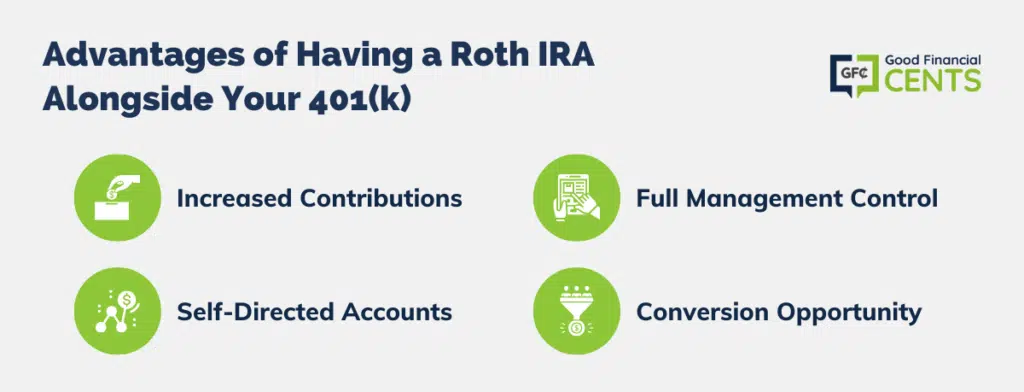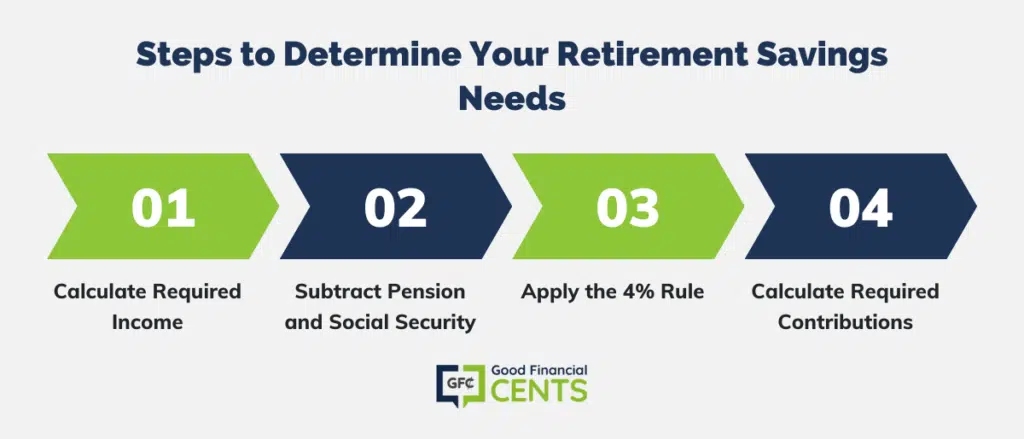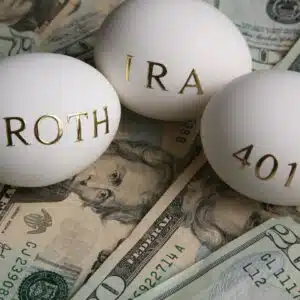Everybody likes to talk about how much they’re contributing to their 401(k) plans or how much they should be contributing to their 401(k) plans.
That’s important, no doubt.
But the bigger question should be the endgame. That’s how much you should have in your 401(k).
That’s the real measure of success or failure of any retirement plan that involves the 401(k) as the main piece.
It’s a tough proposition. Everybody’s in a different situation as far as age, income, immediate financial condition, and risk tolerance.
There’s no scientific way to determine how much you should have in your 401(k), but we’re going to take a stab at it by approaching it from several different angles.
We’ll break it down this way…
Let’s start with the bad news first…
Table of Contents
- The State of American Retirement – It Needs Improvement!
- Contributing Just Enough to Max-Out the Employer Match Will Fail
- You Need to Contribute at Least 20% of Your Income for Retirement
- Don’t Randomly Pick Investments for Your 401(k)
- And Don’t Let Your Co-workers Tell You What Investments to Pick Either!
- While You’re at It – Stay Away From Target Date Funds
- If You Have a Roth 401(k), Take Advantage of It
- Don’t Forget About the Roth IRA, Too
- How Much Should You Have In Your 401(k)?
- Final Thoughts – How Much Should You Have In Your 401(k)?
The State of American Retirement – It Needs Improvement!
According to an article released by Statista, which looked at a data report on adults with any retirement savings in the U.S.,12% of Americans who are 60 years old or older have no retirement savings, and among adults between 18 and 29 years old, 43% haven’t started saving for retirement.
A wide majority of those surveyed expressed concern that they will not have a substantial amount of retirement money to live on, meaning they will continue to work past retirement age.
Many people do not realize what an advantageous opportunity a 401(k) plan offers. It is the most generous of all retirement plans, one that could alleviate much of the concern Americans are expressing over their financial future.
Contributing Just Enough to Max-Out the Employer Match Will Fail
I often recommend contributing at least enough to a 401(k) plan to get the maximum employer match.
If an employer matches 50% up to 3%, then you contribute 6%. That will give you a combined contribution of 9% per year.
But there’s a problem with this recommendation.
It’s not that it’s bad advice – it certainly makes sense for someone who is struggling with financial limits and needs a minimum contribution level.
The problem is when the minimum contribution becomes the maximum contribution. There’s no question, 9% is way better than nothing. But if you intend to retire, it won’t get the job done!
The other problem is that the employer match typically comes with a vesting period. That could be up to five years.
If you stay on the job substantially less, you’ll lose some or all of the match. That will drop you down to only your 6% contribution.
An Example of Contributing Just Enough to Max Out the Employer Match
Let’s assume you’re 35 years old and earn $50,000 per year.
You contribute 6% of your salary to your 401(k) plan, and your employer matches that at 50%, or 3%.
Over the next 30 years, you will earn an average annual rate of return on your investments of 7%.
By the time you’re 65 years old, you’ll have $441,032.
That may seem like a lot of money from where you’re at right now. But when retirement rolls around, it will probably be inadequate.
Here’s why: It’s called the safe withdrawal rate.
It holds that if you limit your withdrawals from your retirement plan to about 4% per year, you will never outlive your money. You can see the wisdom of that, can’t you?
But a retirement portfolio of $441,032 with withdrawals at 4% is just $17,641 per year, and that’s just $1,470 per month.
Since most employers no longer provide traditionally defined benefit pension plans, you’ll have to live on that plus your Social Security benefit.
Let’s say that your Social Security benefit is $1,500 per month.
What kind of retirement will you have with an income of $2,970 per month?
You won’t do much better than just getting by on that kind of retirement income. My guess is that you won’t even be retired at all.
You Need to Contribute at Least 20% of Your Income for Retirement
Most people expect that retirement will be more than just getting by.
Retirement isn’t just a number – it’s the sum total of what you will take out of a lifetime of hard work. It should provide you with an income that will give you more than just basic survival.
For that reason, you need to contribute at least 20% of your income to your retirement plan. The only way for most people to do that is through a 401(k) plan at work.
Let’s look at another example. Let’s have the same financial profile from the last example, but instead of making a 6% contribution, you instead contribute 20% of your salary. The employer match will remain at 3%, giving you a combined annual contribution of 23% of your income.
What will your retirement look like by age 65?
How about $1,127,066?
4% of $1,127,066 will be $45,083, or $3,756 per month. Adding in $1,500 for Social Security, and you’re up to $5,256, which is more than you earn on your job!
Are you getting excited? You should be.
Don’t Randomly Pick Investments for Your 401(k)
Next to low contribution rates, the biggest problem with most 401(k) plans is poor investment selection.
Sometimes that’s inevitable because some 401(k) plans just have a very limited investment selection. But in other cases, the owner of the plan just makes bad choices.
What makes investment choices bad?
- Investing too conservatively by favoring fixed-income investments for safety
- Holding too much company stock, which is a classic case of “putting too many eggs in one basket”
- Not having adequate diversification
- Adding random investments to your plan, like “hot tip” stocks
- Trading too frequently, causes high transaction fees and usually doesn’t work anyway
- Designing your portfolio in a way that’s inconsistent with your long-term goals
Let’s face it, most people are not investment professionals. That means you can’t rely on your own resources to create and manage what will eventually become your largest income-producing asset.
And that means you need to get help.
One source is Personal Capital. That’s an investment service that doesn’t manage your 401(k) plan directly, but it does provide guidance on how to invest in the plan.
They do that through their Retirement Planner and 401(k) Fund Allocation tools.
Another service that’s growing rapidly is Blooom. It’s an investment service that will provide you with investment management for your 401(k) plan.
The service costs just $10 per month, which is a small price to pay to get professional investment advice for your largest asset.
And Don’t Let Your Co-workers Tell You What Investments to Pick Either!
One of the complications with 401(k) plan management is the herd mentality.
It happens in most companies and departments. Someone says to go to the right, and everyone turns to the right without giving it much thought. We’re virtually programmed to operate that way in an organizational environment.
But it’s financial suicide when it comes to investing for retirement.
We should never presume that a coworker, or even a boss, has some sort of superior knowledge when it comes to investments. That person might be bragging about what he is investing in, maybe to get moral support for his decision.
But that doesn’t mean that it’s winning advice.
You, and you alone, will one day need to live on your retirement portfolio. You shouldn’t trust that outcome to what amounts to water cooler gossip.
While You’re at It – Stay Away From Target Date Funds
There’s one type of investment that’s gaining popularity, and I don’t think it’s a healthy development.
It’s a target date fund.
I don’t have a good feeling about them, and that’s why I don’t recommend them.
In fact, I hate target date funds. Does that sound too strong?
Target date funds are one of those innovations that work better in theory than they do in reality.
They start with your retirement date, which is why they’re called “target date funds.” If you plan to retire at age 65, they’ll have tiered plans (which are actually mutual funds).
They have one when you’re 40 years from retirement, another when you’re 30 years out, then 20 years, and 10 years. That may not be exactly how they all work, but that’s the basic idea.
The target dates mostly adjust your portfolio allocation. That is, the closer you are to retirement, the higher the bond allocation is and the less that’s invested in stocks.
The concept is to reduce portfolio risk as you move closer to retirement.
That all sounds reasonable on paper.
But it has two problems.
- One is target date funds have unusually high fees. That reduces the return on your investment.
- The other is they arbitrarily reduce growth in your portfolio as you move closer to retirement.
That generally makes sense, but not for people who either have a higher risk tolerance or who need healthier returns as they move closer to retirement.
Avoid these funds, no matter how hard the pitch is for them.
If You Have a Roth 401(k), Take Advantage of It
A growing twist on the basic 401(k) plan is the Roth 401(k).
It works just like a Roth IRA. Your contributions to the plan are not tax-deductible, but your withdrawals can be taken tax-free.
That’s as long as you are at least 59 ½, and have been in the plan for at least five years.
The Roth 401(k) has two major differences from a Roth IRA.
The first is that the Roth 401(k) is subject to required minimum distributions (RMDs) beginning at age 73. A Roth IRA is not. (You can get around this problem by rolling your Roth 401(k) plan into a Roth IRA.)
The second is the amount of your contribution.
While a Roth IRA is limited to $7,000 per year (or $8,000 if you are 50 or older), contributions to a Roth 401(k) are the same as they are for a traditional 401(k). That’s $23,000 per year or $30,500 if you are 50 or older.
This doesn’t mean that you can put $23,000 in a traditional 401(k) and another $23,000 in a Roth 401(k). You must allocate between the two.
It makes a lot of sense to do this. You will lose tax deductibility on the amount of your contribution that goes to the Roth 401(k).
But by making the allocation, you ensure that at least some of your retirement income will be free from income tax.
If your 401(k) plan offers the Roth option, you should absolutely take advantage of it. It’s a form of income tax diversification for your retirement.
Don’t Forget About the Roth IRA, Too
If your employer doesn’t offer a Roth 401(k), then you should contribute at least some of your retirement money to a Roth IRA.
There are income limits beyond which you cannot contribute to a Roth IRA (those limits don’t apply to Roth 401(k) contributions).
For 2025, your income cannot exceed $146,000 per year if you are single, or $230,000 if you’re married filing jointly. Both of those amounts have increased since last year, meaning those whose earnings were on the fringe of the income limit can now contribute to this rewarding retirement account.
Having a Roth IRA in addition to your 401(k) has several advantages:
- It increases your total retirement contributions. If you are contributing $23,000 to your 401(k) plus $7,000 to a Roth IRA, that raises your annual contribution to $30,000.
- Roth IRAs are self-directed accounts. That means that you can hold the account with a large investment brokerage firm that offers virtually unlimited investment options.
- You will have complete control over how the plan is managed. The account could even be invested with a robo advisor, which will provide you with low-cost professional investment management. (Two popular choices are Betterment and Wealthsimple.)
- You’ll have an account ready and waiting in case you want to do a Roth IRA conversion. It’s a popular way to convert taxable retirement income into tax-free retirement income.
Set up and contribute to a self-directed Roth IRA account if you qualify. It’s become a retirement must-have.

How Much Should You Have In Your 401(k)?
With all the above information in mind, how much should you have in your 401(k)?
The answer is, as much as you think you’ll need to retire.
Does that sound too vague?
Let’s start with this…make sure that you have more in your 401(k) than the average person does. Based on the information presented in the chart at the beginning of this article, the average person won’t be able to retire.
You don’t want to be average. You want to be above average. And you need to be.
And don’t be one of those people who pokes along throughout their career, making the minimum 401(k) contribution to get the maximum employer match.
As I showed earlier, that won’t get you there either.
Let’s go through some steps that can help you determine how much money you’ll need when you retire:
- Determine how much annual income you’ll need when you retire. The rule of thumb is that you use 80% of your pre-retirement income. That’s a good start, but you should make adjustments for variations. This can include higher healthcare and travel expenses but lower housing and debt payments.
- Subtract pension and Social Security income. You can get a pension estimate from your employee benefits department. For Social Security, you can use the Retirement Estimator tool, which will give you an approximate benefit.
- Divide the remaining amount by 0.04. That’s the 4% safe withdrawal rate. It will tell you how large a retirement portfolio you’ll need to produce the necessary income.
- Determine how much you will need to reach that portfolio size. Project how much you will need to contribute to your 401(k) plan and other retirement plans in order to reach the needed portfolio size. Just make sure that your return on investment calculations are reasonable.

Working a Retirement Plan Example
You can get as complicated as you want with this exercise, but let’s keep it simple.
- Let’s assume that you earn $100,000 per year. You estimate the needed retirement income at 80% of that number, or $80,000 per year.
- You expect to receive $30,000 in Social Security income but are not eligible for a pension. That means that your retirement portfolio will need to provide the remaining $50,000 in income.
- Dividing $50,000 by 0.04 (4%), it shows that you will need a retirement portfolio of $1.25 million.
- In order to reach $1.25 million by age 65 (you’re currently 40), it will require that you contribute 20% of your annual income, or $20,000 per year, to your 401(k) plan. This assumes a 3% employer match and a 7% annual rate of return on your investment.
You can also take the easy route by using an online retirement calculator, like the Bankrate Retirement Calculator.
In order to reach his retirement goal, the 40-year-old in our example would need to hit (roughly) the following 401(k) balances at various ages in order to reach $1.25 million by age 65:
- At age 45, $110,000
- Age 50, $260,000
- Age 55, $490,000
- By age 60, $800,000
However you calculate how much you should have in your 401(k), what I want you to take away from this article is that the amount that you actually need is way above what you probably have.
At least that’s the case if you’re the average person.
That’s why I recommend that you decide that you’re not going to be average when it comes to your 401(k) plan. If you want a better-than-average retirement, you’ll need to have a better-than-average plan.
Set your own goals based on your own needs.
Final Thoughts – How Much Should You Have In Your 401(k)?
The focus of 401(k) planning should extend beyond contribution amounts to encompass the ultimate goal of retirement funding.
The inadequacies in American retirement savings underscore the necessity of strategic planning. Relying solely on employer matches falls short of ensuring a comfortable retirement.
Optimal retirement preparedness requires contributing at least 20% of income, diversifying investments prudently, and avoiding herd mentality in decision-making. Capitalizing on Roth 401(k)s and IRAs adds tax diversification.
Calculating retirement needs based on individual circumstances and not settling for the average paves the way to a secure and prosperous retirement.








A 50% match on the first 3% only amounts to an additional 1.5% or did I miss something
I am not sure what you mean target date funds have high fees One factor they are keeping expenses low, which means investors keep more of the return. I have Vanguard Target Retirement 2045 Fund fee is 0.10 I don`t think you will have lower than this
Hi John – It may depend on the fund. Since they’re semi-active managed funds, they do tend to have higher fees.
Nice article. I understand the message you are communicating, but I would like to point out your overstatement of needed funds for retirement. If your income is $100,000 but you are saving $20,000 for retirement, you income is really only $80,000 so 80% needed in retirement is only $64,000. This would reduce needed retirement funds to $850,000. Significantly less than $1,25 million. The underlying premise is still true that most people don’t save enough, however your math logic is not sound.
Good point Darrell. While you’re saving for retirement, the amount you save is an “expense”. Once you retire, it disappears.